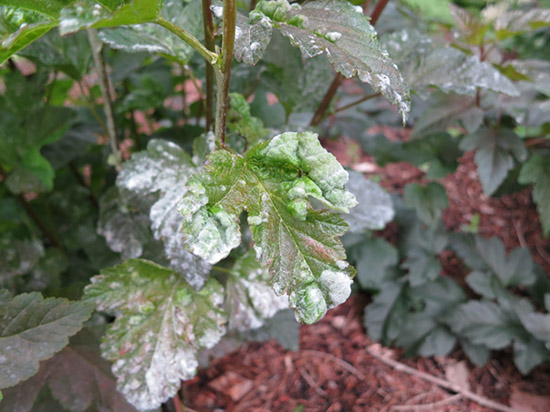Issue 9, June 22, 2015
Powdery Mildews of Ornamentals
Powdery mildews are a group of common fungal diseases that affect woody and herbaceous ornamentals, as well as vegetable and fruit crops. There are hundreds of species of fungi that may cause powdery mildew on various hosts. They are generally host-specific and only infect plants from the same genus or family. Fortunately, these diseases are mostly minor in importance and damage is considered more aesthetically unpleasing than it is harmful. Some host plants may be weakened or have reduced growth resulting from reduced photosynthetic efficiency. This is especially true on fruit and vegetable crops that can lose yield as a result of infection.
Unlike many fungal diseases, powdery mildew does not do well if leaves are wet from frequent rain. Most powdery mildew fungi are inhibited by the presence of free moisture (rain) on leaf surfaces. They are much more common when weather conditions follow a pattern of warm, humid days and cool, damp nights, which most often occurs during spring and fall months. Recently, we have had our fair share of frequent rainfalls. However, there has been enough time between rain events to allow the foliage to dry while maintaining high enough relative humidity to allow for powdery mildew infections to occur.
Symptoms of powdery mildew appear as superficial, white, powdery patches on the leaves. These patches can enlarge and eventually cover the entire leaf, both top and bottom. Young stems, buds, flowers, and fruits can also be affected. The white, powdery patches are composed of threadlike mycelium and asexual spores of the fungus, which are easily blown to other plant parts and cause further infection. New growth is particularly sensitive. A stunting or dwarfing, curling of leaves, chlorosis, premature leaf drop, and deformation of flower buds frequently follow mildew infection.
Controlling powdery mildew diseases can be quite challenging when weather and environmental conditions favor disease development. Start by selecting resistant plant species and varieties and by purchasing high-quality plants from a reputable source. Disease severity may further be reduced by providing conditions for adequate air flow in the planting. Avoid overcrowding plants. Consider the plants size at maturity when spacing plants. Existing plants may require pruning to allow better light penetration and air movement. Because the pathogen thrives in humid conditions, water the plants early in the day to promote rapid drying. Avoid overhead watering, and try to water the soil rather than the foliage.
Numerous fungicides are available to control the mildews, and if sprays are begun at the first sign of mildew, control can be attained. Scout for the appearance of the disease and then treat the plants according to label directions. If damage is minor, no action may be required. Consult the Commercial Landscape & Turfgrass Pest Management Handbook or the Pest Management of the Home Landscape for a list of registered fungicides by host and disease.

Powdery Mildew on Red Horsechestnut

Ninebark with deformed curling leaves caused by powdery mildew.
(Travis Cleveland)
Author:
Travis Cleveland